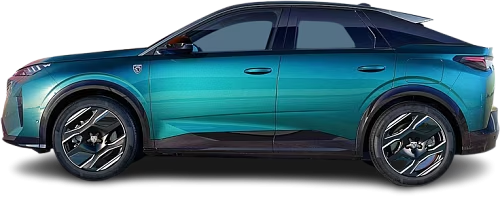USA EV Comparison: Volvo C40 Recharge (EC40) Pure Electric vs Peugeot e-3008 73 kWh FWD
Struggling to Decide? Let AI Help!
Your AI Summary Is Ready!
General Info
While the Peugeot e-3008 73 kWh FWD (2024-…) is currently produced, it is not offered for sale in the United States. The Volvo C40 Recharge (EC40) Pure Electric (2021-2022) has been discontinued, it was never offered for sale in the United States.
The two vehicles share the same body style: SUV.
| Property | Volvo C40 Recharge (EC40) Pure Electric | Peugeot e-3008 73 kWh FWD |
|---|---|---|
| Years of Production | 2021-2022 | 2024-… |
| Current Status | Discontinued | Produced |
| Country of Manufacture | Belgium | France |
| Body Style | SUV | SUV |
| Market Availability | EU | EU |
| GCC Score | 6.1 | 6.3 |
Range and Efficiency
The Peugeot e-3008 73 kWh FWD (2024-…) boasts a greater real-world range, a larger battery, and superior energy efficiency compared to the Volvo C40 Recharge (EC40) Pure Electric (2021-2022).
| Property | Volvo C40 Recharge (EC40) Pure Electric | Peugeot e-3008 73 kWh FWD |
|---|---|---|
| Range (WLTP) | 272 mi | 326 mi |
| Range (GCC) | 232 mi | 255 mi |
| Battery Capacity (Nominal) | 69 kWh | 77 kWh |
| Battery Capacity (Usable) | 67 kWh | 73 kWh |
| Efficiency per 100 mi | 28.9 kWh/100 mi | 28.6 kWh/100 mi |
| Efficiency per kWh | 3.46 mi/kWh | 3.49 mi/kWh |
| Range and Efficiency Score | 6.4 | 7 |
Charging
Both vehicles utilize a standard 400-volt architecture.
The Peugeot e-3008 73 kWh FWD (2024-…) offers faster charging speeds at DC stations, reaching up to 160 kW, while the Volvo C40 Recharge (EC40) Pure Electric (2021-2022) maxes out at 150 kW.
Both vehicles are equipped with the same on-board charger, supporting a maximum AC charging power of 11 kW.
| Property | Volvo C40 Recharge (EC40) Pure Electric | Peugeot e-3008 73 kWh FWD |
|---|---|---|
| Max Charging Power (AC) | 11 kW | 11 kW |
| Max Charging Power (DC) | 150 kW | 160 kW |
| Architecture | 400 V | 400 V |
| Charge Port | CCS Type 2 | CCS Type 2 |
| Charging Score | 6.1 | 6.4 |
Performance
Both vehicles are front-wheel drive.
The Volvo C40 Recharge (EC40) Pure Electric (2021-2022) boasts greater motor power and accelerates faster from 0 to 60 mph.
| Property | Volvo C40 Recharge (EC40) Pure Electric | Peugeot e-3008 73 kWh FWD |
|---|---|---|
| Drive Type | FWD | FWD |
| Motor Type | PMSM | PMSM |
| Motor Power (kW) | 170 kW | 157 kW |
| Motor Power (hp) | 228 hp | 211 hp |
| Motor Torque | 243 lb-ft | 253 lb-ft |
| 0-60 mph | 7.1 s | 8.4 s |
| Top Speed | 99 mph | 106 mph |
| Performance Score | 3.6 | 3.6 |
Dimensions
The Peugeot e-3008 73 kWh FWD (2024-…) is longer and taller, but about the same width as the Volvo C40 Recharge (EC40) Pure Electric (2021-2022).
Both models have similar wheelbase lengths.
| Property | Volvo C40 Recharge (EC40) Pure Electric | Peugeot e-3008 73 kWh FWD |
|---|---|---|
| Length | 174.8 in | 178.7 in |
| Width (with Mirrors) | 80.1 in | 74.6 in |
| Width (w/o Mirrors) | 73.7 in | 74.4 in |
| Height | 62.8 in | 64.6 in |
| Wheelbase | 106.4 in | 107.8 in |
Cargo and Towing
The Peugeot e-3008 73 kWh FWD (2024-…) provides more cargo capacity, featuring both a larger trunk and more space with the rear seats folded.
A frunk (front trunk) is available in the Volvo C40 Recharge (EC40) Pure Electric (2021-2022), but the Peugeot e-3008 73 kWh FWD (2024-…) doesn’t have one.
The Peugeot e-3008 73 kWh FWD (2024-…) is better suited for heavy loads, offering a greater towing capacity than the Volvo C40 Recharge (EC40) Pure Electric (2021-2022).
| Property | Volvo C40 Recharge (EC40) Pure Electric | Peugeot e-3008 73 kWh FWD |
|---|---|---|
| Number of Seats | 5 | 5 |
| Curb Weight | 4343 lb | 4592 lb |
| Cargo Volume (Trunk) | 15 ft3 | 18.4 ft3 |
| Cargo Volume (Max) | 49 ft3 | 52.3 ft3 |
| Cargo Volume (Frunk) | 1.1 ft3 | - Cargo Volume (Frunk) |
| Towing Capacity | 2000 lb | 2756 lb |
| Cargo and Towing Score | 6.4 | 6.7 |




